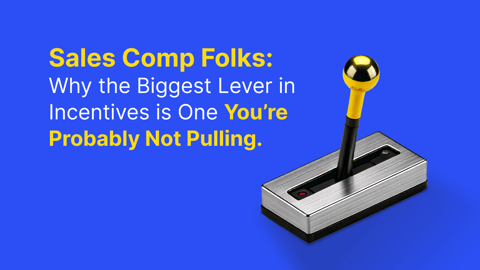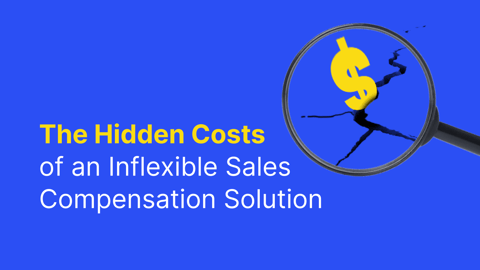We’ve worked with experts in neuroscience and behavioral psychology, pored over academic research studies and reviewed the aggregate data on our platform to understand how incentive compensation plans drive an individual’s best performance. This is your guide to everything you need to know about sales compensation.
The sections below will help you understand how to unlock your team’s productivity and performance through the science of incentives.
- The Purpose of Sales Compensation
- Sales Compensation Terms
- Compensation Plan Design
- Setting Quota for Sales Compensation
- SDR, AE & CS Benchmarks
- Budgeting for Sales Compensation
- Sales Commission Contracts & Compliance
- Accounting for Commissions
The Purpose of Sales Compensation
Do you know what the most common marathon finish time is? 3:59. Not 4:00, not 4:01, and it happens at every milestone. If you’ve ever run a marathon you know this is because there are pacers running with a sign that shows their finish time. People are driven to hit targets. So if you see a pacer running with a 4-hour sign, you’re going to push yourself harder to finish ahead of them. Having a real, objective pacesetter right in front of you is motivating!
So why provide incentive comp? Because targets motivate people. And when you hit one target, it moves you to the next. Comp plans are most effective when there are intermediate targets that build up to quota. Reps perform best when they have targets that they can meaningfully engage with; quotas that are too hard or too easy reduce performance. For example, we recommend setting two accelerator targets below quota and another one-two above quota. Give your reps a pathway to quota and something to aim for after quota attainment.
Commission plans are a feedback loop and feedback loops answer three questions:
- Where am I going?
- How do I get there?
- Based on where I am, what do I do next?
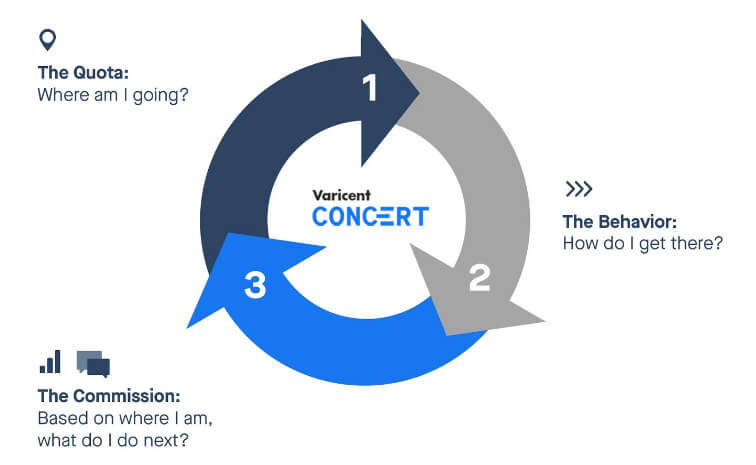
Good quotas are more powerful motivators than the commission itself.
When we see quotas and goals that are achievable, there are psychological and even physiological changes that take place within us. Our brain impacts our performance. Blood pressure increases to prepare the body to leap into action, but this only happens when we see a goal that is moderately challenging (debunking the myth of the stretch target.) Neural pathways that influence behavioral learning activate and prepare us to learn. Overall, smarter targets prepare us to move, prepare us to learn, and help teams perform better.
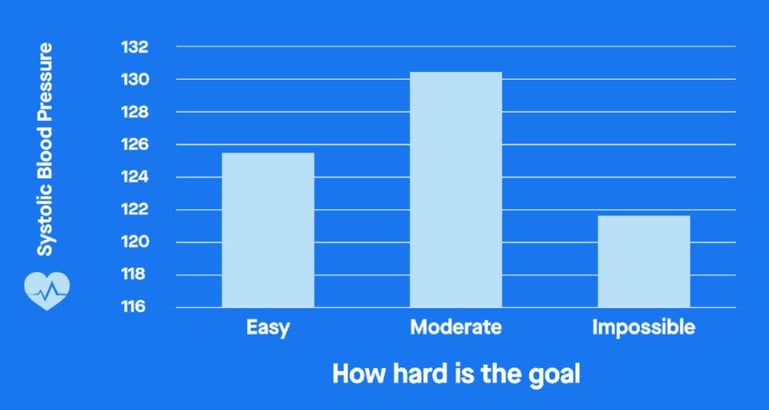
Activities and behaviors, not just outcomes, are important comp levers.
Motivation is most effectively harnessed when we know exactly what we need to do. All of your investments in training and enablement (scripting, role-playing, and coaching) are put into action at this stage. In sales, no behavior is 100% effective, so our teams face a lot of negative feedback in their work. This negative feedback can inhibit an individual’s ability to make this behavior a habit. We advocate paying on pipeline progress in order to provide positive feedback to reinforce the training and enablement investments you are making. Adding a pipeline metric that you pay on (win or lose) will help your sales team learn from pipeline loss and, ultimately, improve their individual productivity and performance.
Commission reporting is feedback, so it matters. This helps to reinforce learning and adjust activities to hit your targets. The rules of any good feedback loop apply here: feedback should be given near real-time, passively, and contextualized against goals. Recent research also shows that feedback delivered by a system is processed twice as effectively as feedback given by a person.
Learn more:
How Meditation Boosts Sales Performance Blog
Sales Compensation Terms
Sales compensation is a sensitive topic; people’s pay is on the line! But it doesn’t have to be confusing. Sales comp, or what a sales rep gets paid, is usually a mix of a base salary and extra financial incentives. It’s used to encourage and set expectations for specific selling behaviors in order to help drive results to achieve individual, team, and company goals. So, we created this guide to make sure we’re all speaking the same language. The following terms are a few from our list that will help you understand the different parts of sales comp and why they matter:
Quota: A way to measure a sales target or goal for an individual or a group. We typically see this calculated as the number of deals closed, dollar amount of deals closed or sales activity.
Accelerator/Achievement Tier: Dependent on the percent to quota goal, this is a range that determines the amount used to calculate commissions. Achievement tiers can be above or below quota in order to encourage performance gates.
On-Target Earnings: On-Target Earnings (OTE) are the total compensation a rep can expect when they reach their quota goals. OTE includes both base salary and 100% commission attainment.
For a full list of terms and concepts, check out this post:
Sales Comp Terms Blog
Compensation Plan Design
A focused comp plan drives performance; your teams will have clearer targets, actions, and feedback. And this will translate to better individual and overall company performance.
Do you struggle coming up with good Customer Success plans? Based on our surveys with Modern Sales Pros over the last two years, we’ve determined that you’re not alone. In 2020, CS plans had an average satisfaction score of 2.77 while SDR and AE plans had an average score of 3.25 and 3.27 respectively. Readjusting your comp plans can be extremely beneficial to impacting your teams’ performance. Want to talk through your CS plans? Schedule a plan assessment here.
Struggling with Customer Success plans isn’t the only disconnect we’ve seen. Sales and marketing have closely linked responsibilities, so why do they rarely see eye to eye? Sales ignore leads from marketing because they are “bad leads.” In return, marketing blames sales for not working their leads. If you’re living in this dysfunction, or see that 50% of sales time is being wasted on poor prospects, it’s time to think about driving closer alignment between your sales and marketing teams. Paying marketing teams for their contribution to pipeline (whether MQLs, SQLs, or some other qualified lead!) is an essential move to aligning marketing and sales and impacting quota attainment. This will be a motivating tool for bringing in the quality leads that your sales team needs to grow your organization.
Learn more:
Retention Rates are Bad CS Metrics (for Comp) Blog
Pay Marketing and Sales for MQLs Blog
Setting Quota for Sales Compensation
The conventional wisdom around quotas seems to be once a rep hits a quota they should be rewarded with an even higher target. Research studies and our data show that’s wrong; instead, quota directly impacts how ready someone is to put in the work to achieve it.
The challenge here is that perception of the target (and the likelihood of achieving it) is extremely individual. This concept, known as psychological distance, combines four components each shaped by individual experience:
Spatial distance – the perception of the quantitative or physical gap
Temporal distance – the perception of the relationship between present and future
Experiential distance – the perception of the difference between imagination and experience
Social distance – the perception of ourselves in relation to others (management, prospects, peers)

Before you or your management team decide to raise quotas it’s critical to think beyond the spreadsheet and answer the following questions:
- How are you changing the team’s psychological distance from your targets?
- How will that increase motivation?
- What are we doing to help shorten those distances?
Learn more:
Raising Quotas? Expect Lower Performance Blog
SDR, AE & CS Benchmarks
The COVID-19 pandemic dramatically changed the way people buy. Sales teams are selling in the face of tremendous customer uncertainty. Budget freezes, rapidly shifting customer priorities, and changing stakeholders all culminate in making quota attainment and reaching compensation targets more challenging than ever. In 2020, satisfaction scores across the board have gone down fairly dramatically for Sales Development, Account Executive, and Customer Success roles.
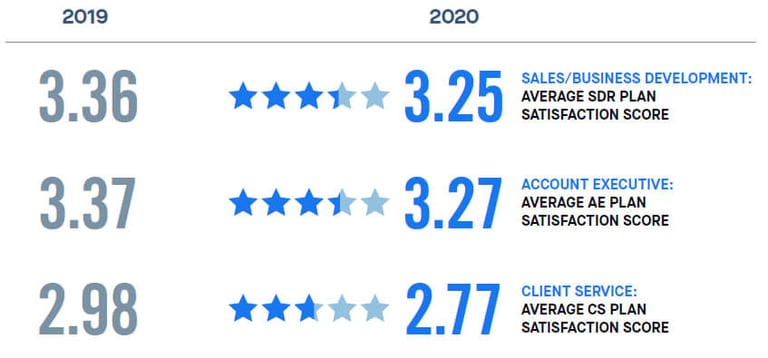
This is in line with what we expected as we went into this year’s annual MSP + Concert State of Sales Comp survey. Most plans over-index outcomes (contract signature, closed won.) When those outcomes are less predictable or harder to achieve, attainment goes down, compensation goes down, and employee retention goes down. Improving sales productivity is the most important challenge for sales and ops leaders to solve, and your comp plans are the most significant tool to do so in your kit. Our How To Create Better Comp Plans in 2022 report will give you a look into SDR, AE, and CS benchmarks and also covers the plan structures, quota and reporting tips that will drive your team’s productivity and happiness.
Learn more:
How to Create Better Comp Plans in 2022 Report
Budgeting for Sales Compensation
Sales compensation budgeting can be really taxing on our brains. We spend a lot of time trying to predict the future when, in reality, it’s just not possible. It’s unreliable to try to predict a whole year out what your team’s performance and business expenses will look like. But when you start to re-frame your uncertainty, you can start making better decisions.
Uncertainty can be broken up into three sources: complexity, ambiguity, and probability. You don’t really know what will happen with your budget months and years from now, but you should have a clearer view of the range of your possible outcomes. There are a lot of moving parts, steps, and assumptions you’re probably making in your sales cycle so stop thinking about average performance and start thinking about the range instead. Ask yourself, what is the actual probability of always reaching your goals? It’s necessary to identify the minimum and maximum results of your sales cycle to more accurately predict this.
Your budget forecast is normally one point on a graph, but with Concert’s Monte Carlo simulation, you can see a much wider expected probability. This analysis simulates 1,000 randomized scenarios against a few different factors to get your sales compensation budget on track.
Sales Commission Contracts & Compliance
Sales commission agreements are often hastily put together and an extremely tedious part of administering sales comp plans. So, we’ve broken down the key points that you need to know so that you have clear, fair, and legally enforceable comp plans.
Sales commission agreements need to cover a few key elements.
- First and foremost, comp plan agreements need to be in writing and signed
- The commission structure must first be outlined in a written agreement and then signed and copied by all parties. Additionally, a sales commission agreement needs to be distributed and signed before the plan goes into effect.
- You need to spell out how a rep can achieve their On-Target Earnings
- It’s important that the agreement clearly spells out exactly how the sales rep will earn their commission. When you’re making offers to your team, you’re indicating the variable comp they will earn in their role. Your agreement needs to show what those outcomes are.
- Explain how the commission will be calculated and paid
- Provide clarity on metrics you’re using to measure performance and include additional conditions that need to be met in order to get credit. Legally, commission payouts are due no later than 30 days after the end of the measurement period.
- Add terms and conditions for “extraordinary” cases
- Clawbacks, Splits, Bluebirds, Family Leave
Concert creates your comp plan agreements for you. No templates to upload. Just enter your plan in Concert and we’ll send your agreements out for signature!
Learn more:
Sales Commission Agreements 101 Blog
Accounting for Commissions
Commission accounting significantly impacts how investors, auditors, and tax authorities view your company. The accounting choices you make will have a significant impact on your benchmarks and how you are viewed against other comparables.
One of your go-to metrics is probably CAC, or Customer Acquisition Cost. This metric measures all of the sales and marketing expenses (including commissions) incurred in a period divided by the number of customers gained in the period. This number (coupled with the expected value of a customer), indicates how efficient your sales processes are, and how scalable and profitable your business can become.
The problem with this method is that accounting for commission expenses has become quite complex under a new rule called ASC 340-40 (or IFRS 15 outside the US.) This rule came into effect in 2018 and 2019, and fundamentally changed the way that we expense commissions. By now, your company should be ASC 340-40 compliant and using this revenue recognition standard as a regular business practice.
Essentially, this rule has forced accountants to view sales activities as part of a lifetime customer relationship.
Some sales activities establish a new long-term relationship (like the commissions a typical AE gets!) You must now expense those activities over the estimated customer lifetime. Other activities further existing customer relationships and should be recognized over the contracted service period. And, some sales activities may or may not even result in revenue. Those activities should be expensed as incurred. And even though accounting for commissions is very technical, it doesn’t have to be hard.
Learn more:
Why Accounting for Commissions Matters Blog
Want to keep talking about Sales Comp?
Book a demo with us to learn how Varicent can help you develop incentive sales compensation plans that will unlock your team’s productivity and performance through the science of incentives.


